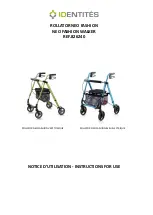Reviews:
No comments
Related manuals for MayorSIT

AL600 Pioneer
Brand: Harmar Mobility Pages: 11

CELEBRITY X
Brand: Pride Mobility Pages: 43

Quantum 610
Brand: Pride Pages: 24

Caribou
Brand: R82 Pages: 148

Merida
Brand: clinicalfly Pages: 4

HSL410
Brand: Harvest Healthcare Pages: 4

NRS 4
Brand: NRS Healthcare Pages: 4

L35555
Brand: NRS Healthcare Pages: 2

H87115
Brand: NRS Healthcare Pages: 2

G21808
Brand: NRS Healthcare Pages: 2

KY692L
Brand: Rainbow Pages: 4

0809175
Brand: Mobiak Pages: 2

0806054
Brand: Mobiak Pages: 3

0805311
Brand: Mobiak Pages: 9

07B
Brand: Queenstone Pages: 35

Walker 12er
Brand: Walker Pages: 16

826240
Brand: identités Pages: 11

826024.B
Brand: identités Pages: 11

















